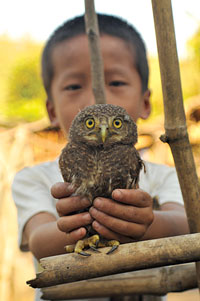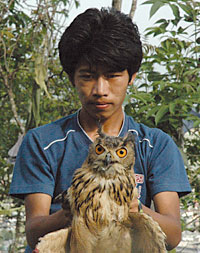 AMRIT GAUTAM |
Charismatic mammals like rhinos, tigers and leopards grab all the headlines, but bird smuggling through Nepal is a growing problem, says Diwakar Chapagain, wildlife trade expert at the Worldwide Fund for Nature (WWF). "Owls and parakeets are just not exciting enough," he says.
Ram Bahadur Gurung, a retired policeman was arrested with a eurasian eagle owl (huchil in Nepali) from Shankhamul in May. He claimed that he found the bird on a tree near Chobar, but it was actually trapped and reared at home for sale in the international market.
The Kaski District Forest Office raided and rescued five owls from three villages of the district in June with the help of the green group, Roots and Shoot Nepal. Villagers said they didn't know capturing the birds was illegal, and said they were planning to rear them as pets.
But Manoj Gautam of Roots and Shoots, who went undercover as a trader, suspects that's not the real story. "We offered to buy the owls and pay more than the other traders, and they quoted Rs 400,000," says Gautam.
 PICS: MANOJ GAUTAM |
Among all the birds trapped in the wild for sale, owls seem to be gaining popularity. Of the 38 owls which had been trapped in Kaski's villages, 31 had been sold already.
The supply of owls is being driven by a surging international demand for the nocturnal birds, which are prized in Europe and sultans' palaces in the Gulf as pets. There is also a growing demand in India, where owls are used in tantrik rituals to exorcise evil spirits and the bones of dead owls are believed to have medicinal properties. There are reports of night-vision experiments conducted on owls.
 |
Villagers can sell an adult huchil to local middlemen for up to Rs 400,000. The bird can can fetch up to 10 times more by the time it is sold to a buyer in the Middle East. Chicks, which are easy to capture, cost anywhere between Rs 5,000-Rs 20,000.
"Owls are easy to catch, and they fetch such a high price, that is the reason for the supply," says Raju Acharya of Friends of Nature who has just co-authored a report on the owl trade. Owls are being severely depleted in 20 districts, with Kanchanpur, Mustang and Kaski the worst affected.
 |
There is evidence that Nepal is also becoming a trans-shipment point for wildlife smuggling in the region. A cargo of 254 exotic birds coming from Pakistan was found atthe Kathmandu airport in April 2007. The consignment contained cockatiels, African grey parrots, macaws worth $1 million in the international market.
Customs officials assured conservationists that the birds would be sent back to where they came from, but were reportedly all destroyed that night. Now, activists suspect officials sent them on to their destination in East Asia after receiving hefty payoffs.
Gautam and other conservations say the airport is just the tip of the iceberg, the real smuggling routes are on the road links across the northern and southern borders.


